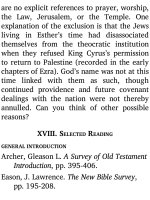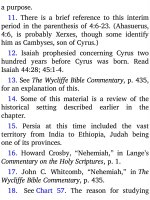Jensens survey of the old testament adam 271
Bạn đang xem bản rút gọn của tài liệu. Xem và tải ngay bản đầy đủ của tài liệu tại đây (117.34 KB, 4 trang )
meaning
“uncovering,”
“disclosure,”
“revelation”). This is why the book is often
referred to as “The Book of Revelation of the
Old Testament.” As such, it is very
appropriate that the book appears as the
next to the last book of the Christian canon
of the Old Testament.
I. BACKGROUND OF THE BOOK OF ZECHARIAH
A. THE MAN ZECHARIAH
1. Name. The Hebrew name Zechariah
means “The Lord remembers.” It was a
common name in Old Testament times
(around thirty men in the Old Testament are
so named). Many parents no doubt gave the
name as an act of gratitude to the Lord for
remembering them with the gift of a baby
boy.
2. Family. Zechariah’s father was the priest
Berechiah; his grandfather, priest Iddo
(1:1).10 Zechariah’s family was among the
Jewish exiles who returned from Babylon in
5 3 6 B.C. under Zerubbabel (read Neh 12:4,
16). Zechariah was a young child at that
time, if he was a young man when he began
to prophesy in 520 B.C. (The “youhg man” of
2:4 may be Zechariah.)
3. Ministry. In 520 B.C., when God began
revealing to Haggai the message he should
preach and write, Zechariah was ministering
to the Jews as a priest, a position passed
down from his forefathers (Neh 12:16).
Then, two months later, Zechariah was
commissioned with a similar prophetic task
(cf. Hag 1:1 and Zech 1:1). This made him a
prophet-priest,
like
his
predecessors,
Jeremiah and Ezekiel. Jewish tradition
honors Zechariah (along with Haggai and
Malachi) as a priest of the Great Synagogue,
responsible for gathering and preserving the
sacred writings and traditions of the Jews
after the Babylonian Exile.
The main task that Zechariah and Haggai
shared was to exhort the Jews to nish
rebuilding the Temple. This project had
been discontinued in 534 B.C., fourteen years
before the prophets began their ministry.
Read Ezra 6:14-15 to learn how successful
the prophets were. In what year was the
Temple completed?
B. THE BOOK OF ZECHARIAH
1. Date. There are datelines in the book of
Zechariah: at 1:1; 1:7; and 7:1. The second
year of Darius (1:1) was 520 B.C., and the
fourth year (7:1) was 518 B.C. The opening
words of 8:1 suggest a later revelation to
Zechariah, as do the opening words of 9:1.
How much later these revelations were
given, however, cannot be determined. It is
possible that chapters 1-8 were written
during the building of the Temple (520-516
B.C.); and chapters 9-14, after the Temple
was completed in 516 B.C. (see Chart 116).
2. General contents. Like all biblical
prophecy, the book of Zechariah contains
both foretelling and forthtelling. The
forthtelling is the prophet’s appeal to the
people concerning their heart relationship to
God, so that the work of their hands (e.g.,









